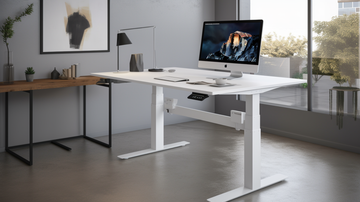Standing desks have grown increasingly popular in recent years as more people become aware of the health benefits associated with standing while working. If you're interested in incorporating a standing desk into your workspace but don't want to invest in a costly pre-made model, this guide is for you. We'll walk you through the entire process of building your own custom standing desk from scratch, allowing you to create a functional and stylish piece of furniture tailored to your specific needs and preferences.
- Determine your requirements: Before you start, consider the following factors to determine the ideal standing desk for your workspace:
- Desired desk height: Measure the height at which you feel comfortable working while standing. This is crucial for ensuring ergonomic comfort and preventing strain or injury.
- Workspace dimensions: Assess the available space in your work area to determine the size of the desk you can accommodate.
- Storage and functionality: Consider your storage and organizational needs, and whether you want additional features like adjustable shelves or cable management systems.
-
Choose your materials and tools: Select the materials for your standing desk based on your budget, desired aesthetics, and durability requirements. Common materials include wood, plywood, and metal. Gather the necessary tools, such as a saw, drill, screws, wood glue, measuring tape, level, and sandpaper.
-
Design your standing desk: Sketch out your standing desk design, including measurements for each component. Your design should include the following elements:
- Desk surface: This is the main work area of your standing desk. Ensure it is large enough to accommodate your computer, keyboard, mouse, and any other essential items.
- Legs or support structure: Your desk will need sturdy legs or a support structure to hold it at the desired height. Consider using adjustable legs if you'd like the option to switch between sitting and standing.
- Additional features: Add any desired extras, such as shelves, drawers, or cable management systems, to your design.
-
Cut and assemble the components: Using your design as a guide, cut the materials to the appropriate dimensions. Sand any rough edges, and begin assembling the desk components. Use wood glue and screws to secure the joints and create a stable structure.
-
Add any extra features: Install any additional features you've incorporated into your design, such as adjustable shelves, drawers, or cable management systems. Ensure these elements are properly secured and functional.
-
Finish and protect your standing desk: Depending on your chosen materials, apply a finish to your standing desk to enhance its appearance and protect it from wear and tear. For wooden desks, consider using a stain or paint followed by a clear protective coat. For metal desks, you might apply a coat of rust-resistant paint.
-
Set up your new standing desk: Position your completed standing desk in your workspace, ensuring it is level and secure. Arrange your computer, keyboard, mouse, and other essential items on the desk surface, and adjust the height if necessary to achieve ergonomic comfort.
Conclusion: Building your own standing desk is a rewarding project that allows you to create a customized and functional piece of furniture for your workspace. By following this comprehensive guide, you'll be able to design and construct a standing desk tailored to your specific needs and preferences. Enjoy your new standing desk and the health benefits that come with working in a more ergonomic and active position!






